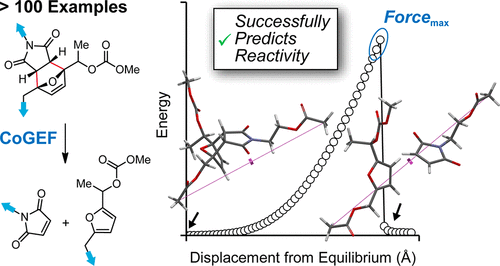当前位置:
X-MOL 学术
›
J. Am. Chem. Soc.
›
论文详情
Our official English website, www.x-mol.net, welcomes your feedback! (Note: you will need to create a separate account there.)
Validation of the CoGEF Method as a Predictive Tool for Polymer Mechanochemistry
Journal of the American Chemical Society ( IF 15.0 ) Pub Date : 2020-09-09 , DOI: 10.1021/jacs.0c06868 Isabel M Klein 1 , Corey C Husic 1 , Dávid P Kovács 1 , Nicolas J Choquette 1 , Maxwell J Robb 1
Journal of the American Chemical Society ( IF 15.0 ) Pub Date : 2020-09-09 , DOI: 10.1021/jacs.0c06868 Isabel M Klein 1 , Corey C Husic 1 , Dávid P Kovács 1 , Nicolas J Choquette 1 , Maxwell J Robb 1
Affiliation

|
The development of force-responsive molecules called mechanophores is a central component of the field of polymer mechanochemistry. Mechanophores enable the design and fabrication of polymers for a variety of applications ranging from sensing to molecular release and self-healing materials. Nevertheless, an insufficient understanding of structure-activity relationships limits experimental development, and thus computation is necessary to guide the structural design of mechanophores. The constrained geometries simulate external force (CoGEF) method is a highly accessible and straightforward computational technique that simulates the effect of mechanical force on a molecule and enables the prediction of mechanochemical reactivity. Here, we use the CoGEF method to systematically evaluate every covalent mechanophore reported to date and compare the predicted mechanochemical reactivity to experimental results. Molecules that are mechanochemically inactive are also studied as negative controls. In general, mechanochemical reactions predicted with the CoGEF method at the common B3LYP/6-31G* level of density functional theory are in excellent agreement with reactivity determined experimentally. Moreover, bond rupture forces obtained from CoGEF calculations are compared to experimentally measured forces and demonstrated to be reliable indicators of mechanochemical activity. This investigation validates the CoGEF method as a powerful tool for predicting mechanochemical reactivity, enabling its widespread adoption to support the developing field of polymer mechanochemistry. Secondarily, this study provides a contemporary catalog of over 100 mechanophores developed to date.
中文翻译:

CoGEF 方法作为聚合物机械化学预测工具的验证
被称为机械团的力响应分子的发展是聚合物机械化学领域的核心组成部分。机械团能够设计和制造聚合物,用于从传感到分子释放和自修复材料的各种应用。然而,对构效关系的理解不足限制了实验的发展,因此需要计算来指导机械团的结构设计。受约束的几何形状模拟外力 (CoGEF) 方法是一种易于访问且直接的计算技术,可模拟机械力对分子的影响并能够预测机械化学反应性。这里,我们使用 CoGEF 方法系统地评估迄今为止报道的每个共价机械团,并将预测的机械化学反应性与实验结果进行比较。机械化学上无活性的分子也作为阴性对照进行研究。一般而言,在密度泛函理论的常见 B3LYP/6-31G* 水平下使用 CoGEF 方法预测的机械化学反应与实验确定的反应性非常一致。此外,将从 CoGEF 计算获得的键断裂力与实验测量的力进行比较,并证明是机械化学活性的可靠指标。这项研究验证了 CoGEF 方法作为预测机械化学反应性的强大工具,使其广泛采用以支持聚合物机械化学的发展领域。其次,
更新日期:2020-09-09
中文翻译:

CoGEF 方法作为聚合物机械化学预测工具的验证
被称为机械团的力响应分子的发展是聚合物机械化学领域的核心组成部分。机械团能够设计和制造聚合物,用于从传感到分子释放和自修复材料的各种应用。然而,对构效关系的理解不足限制了实验的发展,因此需要计算来指导机械团的结构设计。受约束的几何形状模拟外力 (CoGEF) 方法是一种易于访问且直接的计算技术,可模拟机械力对分子的影响并能够预测机械化学反应性。这里,我们使用 CoGEF 方法系统地评估迄今为止报道的每个共价机械团,并将预测的机械化学反应性与实验结果进行比较。机械化学上无活性的分子也作为阴性对照进行研究。一般而言,在密度泛函理论的常见 B3LYP/6-31G* 水平下使用 CoGEF 方法预测的机械化学反应与实验确定的反应性非常一致。此外,将从 CoGEF 计算获得的键断裂力与实验测量的力进行比较,并证明是机械化学活性的可靠指标。这项研究验证了 CoGEF 方法作为预测机械化学反应性的强大工具,使其广泛采用以支持聚合物机械化学的发展领域。其次,



























 京公网安备 11010802027423号
京公网安备 11010802027423号